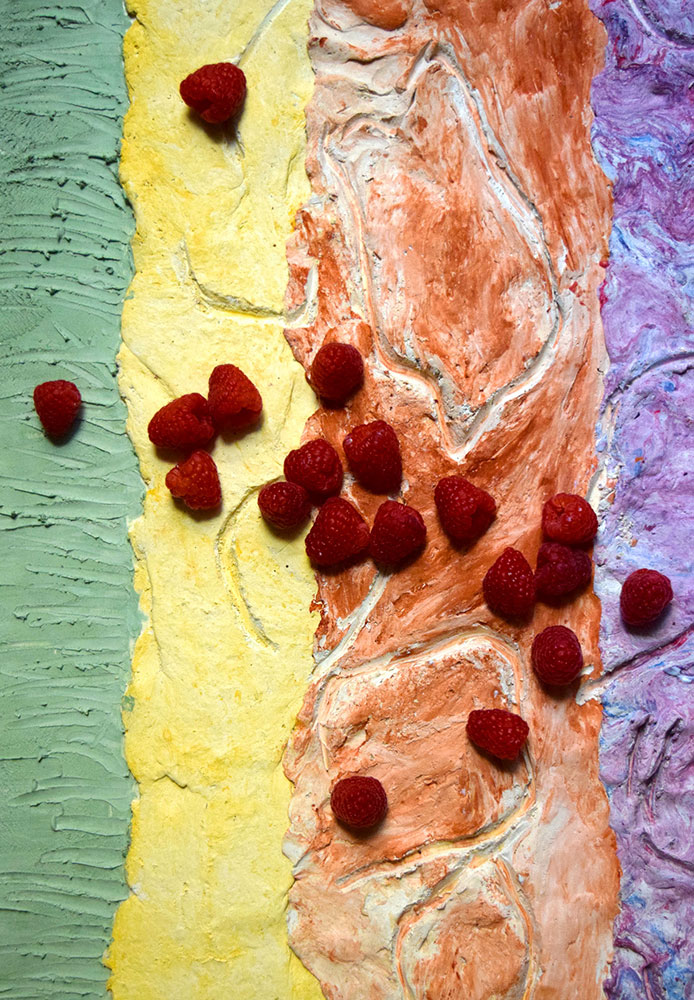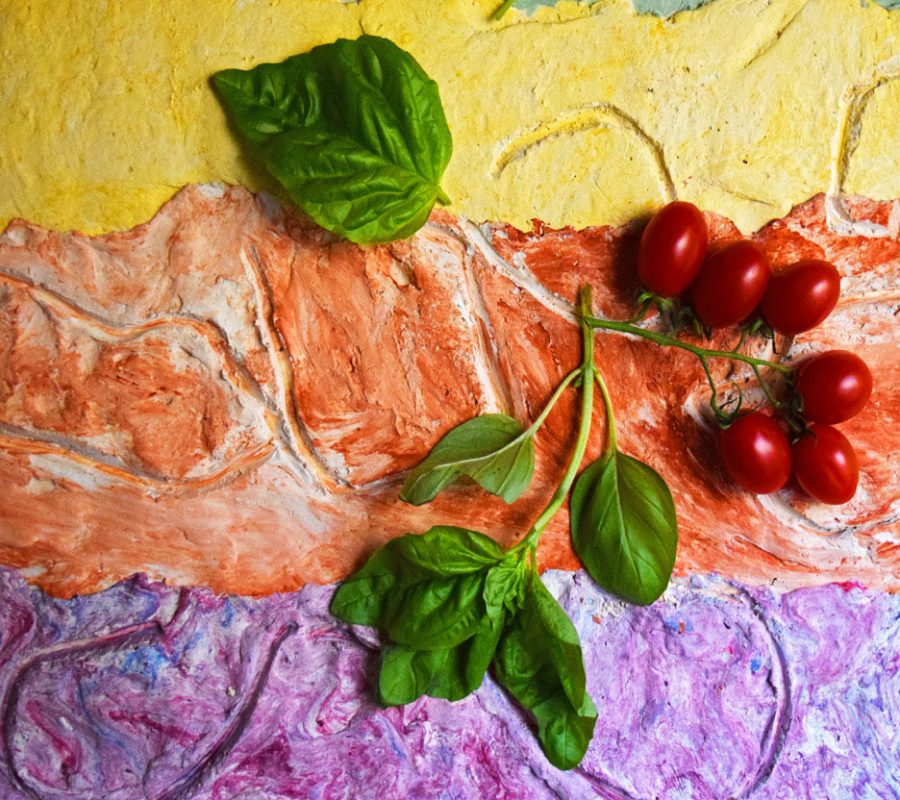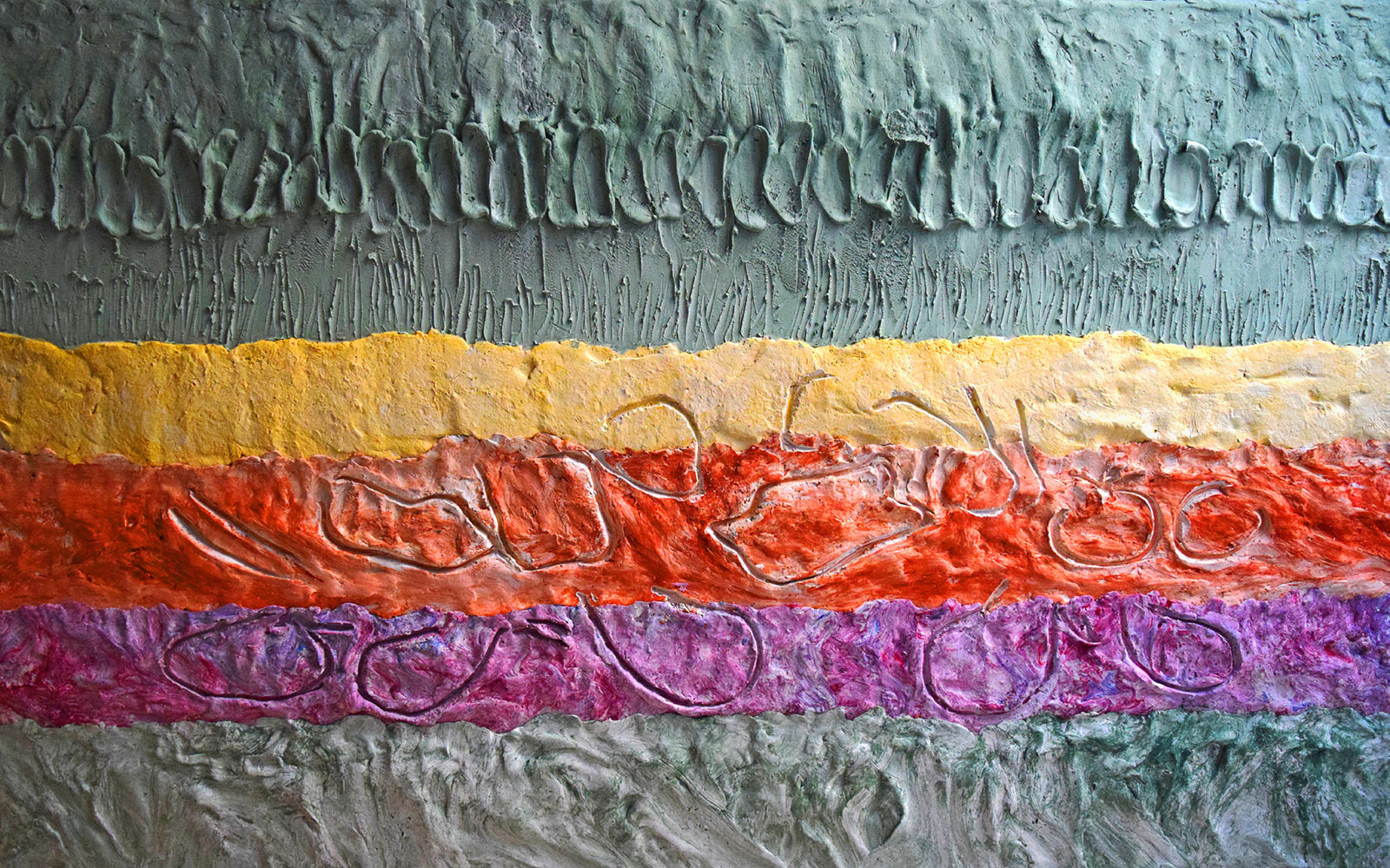E-
STA-
TE
The summer heat on the Murgia dries out the prairie and offers us refreshment under the large centuries-old oaks.

The vegetable garden also benefits and colorful vegetables are harvested to prepare tasty dishes, rich in useful properties in this season. Eggplant, pepper, courgette, tomato, used to seeing them all year round on the table thanks to greenhouse cultivation, are instead vegetables of this period and therefore more than ever rich in their nutritional characteristics, useful for the preparation of light dishes
Tradition enriches these vegetables with the addition of fillings, making them become real one-dish meals. Among the summer vegetable varieties of Puglia we find some that are part of the traditional crop so much so that they have earned the PAT denomination. We are talking about the Carosello and the Barattiere – also called cianciuffo or cucumarazzo – are two ecotypes of the Cucumis melo species. Rich in water, vitamins A, C and mineral salts (potassium, sodium, calcium and phosphorus) ideal in this season, they are also used for the preparation of fresh dishes such as the traditional Cialledda.
Another green touch on the table is given by Chicory – Cichorium intybus – eaten raw or cooked, it is never missing from the tables of this region. The Murgia offers us the spontaneous variety and in the garden we collect the spigata also called Catalogna, also rich in vitamins A and C, mineral salts (phosphorus, potassium, calcium) and has a diuretic action.
Tradition enriches these vegetables with the addition of fillings, making them become real one-dish meals. Among the summer vegetable varieties of Puglia we find some that are part of the traditional crop so much so that they have earned the PAT denomination. We are talking about the Carosello and the Barattiere – also called cianciuffo or cucumarazzo – are two ecotypes of the Cucumis melo species. Rich in water, vitamins A, C and mineral salts (potassium, sodium, calcium and phosphorus) ideal in this season, they are also used for the preparation of fresh dishes such as the traditional Cialledda.
Another green touch on the table is given by Chicory – Cichorium intybus – eaten raw or cooked, it is never missing from the tables of this region. The Murgia offers us the spontaneous variety and in the garden we collect the spigata also called Catalogna, also rich in vitamins A and C, mineral salts (phosphorus, potassium, calcium) and has a diuretic action.

Among the wild plants we find one considered a weed but with such richness that it represents a real treasure: Purslane – Portulaca oleracea – a succulent herb with small, fleshy leaves of light green color and a reddish stem.
Purslane, in addition to having mineral salts and good quantities of vitamins A, C and those of the B group, is one of the major plant sources of fatty acids of the Omega-3 group – 100 g of Portulaca leaves contain approximately 350 mg of linolenic acid, a rare characteristic in the plant world. In the kitchen it is used as a mixed salad for salads and for the preparation of first courses, side dishes and omelettes. In the basket of wild herbs we also find Plantain – Plantago Laceolata – a wild medicinal plant, very widespread, it is found along the sheep tracks and in uncultivated lands, present all year round, in summer it is at its maximum growth. With antibacterial and anti-inflammatory properties, it enriches the preparations in the kitchen.
An intense aroma comes to us from Wild Fennel – Foeniculum sylvestre. It is one of the most widespread and well-known Mediterranean herbaceous plants. Its use in cooking is varied and it lends itself to being eaten raw, cooked, to accompany some dishes or simply to ‘perfume’ foods, as an addition to cooking typical lamb dishes.
Purslane, in addition to having mineral salts and good quantities of vitamins A, C and those of the B group, is one of the major plant sources of fatty acids of the Omega-3 group – 100 g of Portulaca leaves contain approximately 350 mg of linolenic acid, a rare characteristic in the plant world. In the kitchen it is used as a mixed salad for salads and for the preparation of first courses, side dishes and omelettes. In the basket of wild herbs we also find Plantain – Plantago Laceolata – a wild medicinal plant, very widespread, it is found along the sheep tracks and in uncultivated lands, present all year round, in summer it is at its maximum growth. With antibacterial and anti-inflammatory properties, it enriches the preparations in the kitchen.
An intense aroma comes to us from Wild Fennel – Foeniculum sylvestre. It is one of the most widespread and well-known Mediterranean herbaceous plants. Its use in cooking is varied and it lends itself to being eaten raw, cooked, to accompany some dishes or simply to ‘perfume’ foods, as an addition to cooking typical lamb dishes.
TRADITIONAL DISHES
THE HEAT OF SUMMER MAKES US APPRECIATE FRESH FOOD AND EVEN THE MURGIAN TRADITION REFERS US TO COLD DISHES USEFUL IN THIS SEASON. VEGETABLES OF ALL COLORS AND WILD HERBS COMBINED TO RECHARGE WITH MINERAL SALTS.

SIDE DISHES
Cialledda
Cold dish made with tomato, onion, carosello, mixed with salt, plenty of olive oil, and when everything is mixed, add pieces of slightly wet stale bread. Leave to flavor covered and in the refrigerator. Serve very cold and with a sprinkling of oregano or basil. The bread can be replaced with boiled potatoes cut into pieces.
Eggplants or peppers or fungtid (mushroom-like)
Dice the eggplant and tomato. Separately prepare a light soffritto with olive oil and garlic. Add the diced tomato and then the chopped eggplant. At the end of cooking add some fresh basil. In the variant with pepper, also add the onion to the soffritto and season at the end with capers.
Zucchini alla poverella – or scapece
Cut and dry the zucchini slices in the sun. After a day they will be ready to be lightly fried in olive oil and seasoned with salt, garlic, a little vinegar and fresh mint.Green beans and potatoes
Boil the green beans and potatoes, drain and season with salt, extra virgin olive oil. Serve cold and with a squeeze of lemon.Baked onions
Choose some large onions, boil them for five minutes in salted water. Drain them and season them in a pan with vinegar, a little sugar and olive oil. You can enrich it with the addition of celery and cherry tomatoes. At the end of cooking the sugar on the surface will have created a tasty crust.FIRST DISHES
The first course of fresh pasta is always present on the tables of Puglia even in summer. The light condiments bring the flavor of freshly picked vegetables. A touch of basil with the tomato and mint with the courgettes is a must.
Cavatelli with tomato and basil
The traditional cavatello heated in water and salt is seasoned with a sauce made with seasonal tomatoes, onion and olive oil. At the end of cooking add the basil and season the pasta with a generous handful of ricotta marzotica.Vermicelli with chard
Heat the chicory with the vermicelli. Drain and pour into the pan the sautéed seasoning already prepared with olive oil, garlic and cherry tomatoes. Mix over low heat and season with pecorino cheese or ricotta marzotica.Cavatelli with wild vegetables
A rustic condiment made with seasonal wild herbs cooked and sautéed in a pan with olive oil and garlic, to which the already heated pasta will be added. Mix the flavors over a low heat. It can be served with flakes of caciocavallo or pecorino.Spaghetti with courgettes
Prepare the dressing with the courgettes cut lengthwise and cooked with a light sauté of olive oil and garlic. At the end of cooking add plenty of fresh mint and the spaghetti just drained. Mix over low heat with the addition of flakes of local aged cheese.Spaghetti with purslane
Purslane, a wild herb of this season, with rich properties, is heated and passed in the pan with olive oil and garlic to complete the short cooking. Add the spaghetti just drained and mix. This simple preparation allows you to appreciate the flavors of this wild herb.VEGETABLES
Stuffed vegetables are a unique dish full of flavor. Very common as a preparation, each recipe brings with it variations. It is difficult to decide which is the best. Some preparations…
Stuffed eggplant
The aubergines cut in half are emptied of their insides that will be chopped and cooked with olive oil and a little garlic, until they reduce in volume. This is the base of the filling that is seasoned with grated cheese, cherry tomatoes, parsley, a little stale bread, previously soaked, egg, a little parsley and extra virgin olive oil. Once the emptied and fried cups are filled, they are placed in the pan, sprinkled with simple sauce and baked. But they can also be cooked on the stove.Stuffed and au gratin peppers
We proceed in the same way as for the aubergines, for the filling of the peppers, with the addition of capers and anchovies. We arrange them in a baking tray seasoned with olive oil, some cherry tomatoes and a little water to facilitate baking in the oven. Gratinate at the end of cooking.Stuffed tomatoes
Same procedure as the filling already described, also for the tomatoes, to which you can add basil. Arrange them in a pan with olive oil, sprinkled with breadcrumbs, cook in the oven until gratinated.Stuffed potatoes
The boiled and peeled potatoes are cut in half and the inside is hollowed out to obtain a cradle. The filling is prepared with minced meat, the rest of the hollowed out potato, the caciocavallo in chunks, a little wild spices and the cradles are filled which will be placed on the bottom of the pan with a splash of olive oil and rosemary. Bake until gratinated. Serve hot.MEATBALLS
Meatballs are a very common type of food in the Apulian Lucanian territory. They represented an enrichment of lunches and dinners. That little something extra, but which in reality has the structure of a second course or a single dish. Some preparations…
Eggplant meatballs
Peel the eggplant and cut it into small pieces, fry it in olive oil, drain it and mix it with a little stale bread soaked in water, a generous handful of local aged cheese, salt, parsley and egg. Fry in small portions and serve hot or cold.Bread meatballs with sauce
Prepare the dough with stale bread soaked in water and milk, squeezed and seasoned with eggs, plenty of cheese, parsley and a little chopped garlic. Prepare the meatballs and fry them in olive oil. Drained from the oil, they are passed in plenty of sauce and cooked for a few minutes to allow the sauce to penetrate the meatball. Serve hot, but they are also excellent cold.Meatballs with wild herbs
We heat the mix of wild herbs and sauté in a pan with olive oil and garlic, then mix with eggs, local aged cheese and grated potato. We form small portions to pass in grated stale bread and fry. Serve hot. Baking can be a great alternative.SWEETS
Among the desserts we find ricotta, which was often used as a simple and poor dessert, beaten with sugar and spread on bread. Also used as a filling for shortcrust pastry, ricotta lends itself well to being combined with seasonal wild fruit, figs and blackberries and for spoon desserts. Some preparations…
Sweet ricotta pizza
Mix the sheep ricotta with the whole eggs and sugar, a little cinnamon, grated lemon and pieces of dark chocolate. Pour into an oiled pan and bake.Ricotta and fruit shortcrust pastry
The cooked shortcrust pastry is filled with ricotta whipped with sugar and grated lemon peel, and flavored with lemon rosolio. It is garnished with seasonal wild fruit: figs and blackberries.Fruit and ricotta cup
Prepare a bowl of fresh seasonal fruit, macerated with lemon and a few leaves of fresh mint. Separately, whip the ricotta with sugar and grated lemon peel. Garnish the fruit bowl with the ricotta cream and serve cold.Sighs or Nun’s Breast
Single-serving dessert with a dough made from eggs, sugar and starch, very soft and filled with custard after baking. It is dusted with powdered sugar or covered with a white sugar glaze.SWEETS
It is traditional to preserve the fruits of the summer to consume them at other times of the year. Among the most common preserves in Puglia we find the dried fig. Harvested in the summer, it is dried in the sun and stored in cloth bags. The dried fig, in the peasant tradition, was considered an excellent reserve of sugar. The figs dried in this way could also become Fichi chiacune. They were divided in half without separating them at the base, a toasted almond was placed in the center of the two sections and closed with a second fig, making it fit together. This operation was followed by a quick ‘baking’ and while still hot they were placed in jars, in layers, alternating with bay leaves and fennel seeds. In the summer, Blackberries are harvested on the Murgia with which an excellent jam is prepared for tarts and ricotta desserts. In autumn, the abundance of Grapes and Quinces allow the preparation of jams to fill holiday desserts. In winter, with the harvest of Hawthorn and Rosehip berries, it is possible to make fine jams for special moments of the day.
ROSOLI
Rosolio is the name used in the past to indicate sweet and flavored liqueurs of moderate alcohol content. The homemade liqueur that was served with desserts to welcome the guest. The preparation is simple, what makes the difference are the essences that are used for the infusion with alcohol. It is important to use a hermetically sealed container, pour in the pure alcohol and the chosen essence, close it and leave it to rest in the dark for two or three weeks. During this entire period, shake the container a couple of times a day. At the end of the infusion period, a syrup prepared with water and sugar is added. After a few days, filter and leave to rest for a few weeks before consuming it. Each essence gives its name to the rosolio. In the Murgia area, among the best known we find the Nocino or Padre Peppe obtained from the infusion of fresh walnuts and the Centerbe which is born from the infusion of many wild herbs and not only. But there are so many rosolios, to name just a few: Lemon, Cherry, Pomegranate, Laurel, Wild Fennel.
Another type of traditional rosolio is the one prepared with Coffee and Chocolate. The latter is also called Chocolate liqueur, with a dense and creamy consistency.
HERBAL TEAS AND INFUSIONS
With the collection of wild herbs, at the laboratory of medicinal herbs of donnapaola we prepare mixtures for precious cure-alls. Herbal teas and infusions with the properties of flowers, leaves and roots collected on the Murgia. Herbal tea with mallow, calendula, hawthorn, dog rose, just to name a few.
EDIBLE HERBACEOUS SPECIES OF THE APULIA FLORA
PRESENT IN THE MURGIAN TERRITORY OF DONNAPAOLA
Biodiversity is one of the distinctive features of the donnapaola company. Its territory is rich in edible plants that have always accompanied the life of the populations of this land. Used for food and medicine, wild herbs represent a true heritage. Leaves, stems, roots and flowers, everything contributes to the recovery of good practices.
Below we offer you a list of plants used for the preparation of dishes.
| NOME SCIENTIFICO | NOME VOLGARE | FAMIGLIA | PARTE EDULE |
|---|---|---|---|
| Anagallis arvensis L. | Centocchio dei campi | Primulacea | Foglia |
| Asparagus acutifolius L. | Asparago pungente | Liliaceae | Stelo |
| Asphodeline lutea L. Rchb. | Asfodelo giallo | Liliaceae | Stelo radice |
| Bellis perennis L. | Pratolina comune | Asteraceaea | Foglia fiore |
| Calamintha nepeta (L.) Savi | Mentuccia comune | Lamiaceaea | Foglia |
| Cichorium intybus L. | Cicoria comune | Asteraceaea | Foglia |
| Clinopodium vulgare L. subsp. | Clinopodio dei boschi | Laminaceaea | Foglia |
| Echium vulgare L. | Viperina azzurra | Boraginaceae | Foglia |
| Ferula communis L. | Ferula comune | Apiaceae | Stelo |
| Foeniculum vulgare Mill. | Finocchio comune | Apiaceae | Stelo infiorecsenza |
| Malva sylvestris L. | Malva selvatica | Malvaceae | Fiore |
| Marrubium vulgare | Marrubio comune | Lamiaceae | Stelo foglia |
| Nigella damascena L. | Damigella scapigliata | Ranuncolaceae | Foglia |
| Onobrychis caput-galli (L.) Lam. | Lupinella cresta di gallo | Fabaceae | Baccello fresco |
| Ornithogalum umbellatum L. | Latte di gallina comune | Liliaceae | Bulbo |
| Picris hieracioides L. | Asparagina comune | Asteraceae | Foglia |
| Portulaca oleracea L. subsp. | Porcellana comune | Portulacaceae | Foglia stelo |
| Reichardia picroides (L.) Roth | Grattalingua | Asteraceae | Foglia |
| Rubus ulmifolius Schott | Rovo comune | Rosaceae | Frutto seme |
| Salvia verbenaca L. | Salvia minore | Lamiaceae | Foglia |
| Sanguisorba minor Scop. | Salvastrella minore | Rosaceae | Foglia |
| Scolymus hispanicus L. subsp. | Cardogna comune | Asteraceae | Radice foglia |
| Scorpiurus muricatus L. | Erba lombrica comune | Fabaceae | Baccello fresco |
| Sedum rupestre L. subsp. | Borracina rupestre | Crassulacea | Stelo foglia |
| Sonchus oleraceus L. | Grespino comune | Asteraceae | Foglia |
| Tordylium apulum L. | Ombrellini Pugliesi | Apiaceae | Seme foglie |
| Tragopogon porrifolius L. | Barba di becco violetta | Asteraceae | Radice foglia stelo |
| Tribulus terrestris L. | Tribolo comune | Zigophylitaceae | Foglia stelo |
| Urospermum dalechampii (L.) | Boccione maggiore | Asteracea | Foglia |
| Vicia villosa Roth | Veccia pelosa | Fabaceae | Foglia stelo |
| Salvia verbenaca L. | Salvia minore | Lamiaceae | Foglia |
| Sanguisorba minor Scop. | Salvastrella minore | Rosaceae | Foglia |
| Scolymus hispanicus L. subsp. | Cardogna comune | Asteraceae | Radice foglia |



